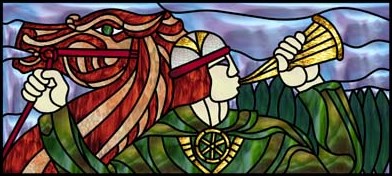Design of the Month · June 2007
-

"Kalev"
Design in what we now call the Czech Republic had something of a heyday in the late 19th and early 20th centuries, with the proliferation of the organic curvaceousness of Art Nouveau and onto its distinctly Eastern European interpretation of Art Deco and Modernism. Indeed the USSR was very aware of the importance of Czech art and architecture and thankfully destroyed none of it! Kalev comes from a distinct Art Moderne influence with a communist (hard working off the land) and traditional design base. Those of you from the United Kingdom and in your 40s or 50s may remember the TV serialised children's stories, such as the Singing Ringing Tree, and see some resemblance in the imagery in Kalev.
I like to experiment with stained glass and push what I conceive to be the construction boundaries, without resorting to what I consider to be a glazed version of painting-by-numbers. I am likely to cut glass into long thin strips or curves and add deep inside curves. Therefore, Kalev has what many traditionalists consider to be bad design features. To that I say, if you don't try you don't know… so I keep pushing the borders of "acceptability"! Kalev is designed using lead came but could easily be made using the Tiffany method. I have chosen glass whimsically, as I normally do, and being colour-blind (I see the full spectrum just not necessarily in the right places) you may consider the selection odd or eclectic, so change what you will.
As this is now my full-time business I may never get to make Kalev unless he is commissioned, but the design will appear on my website soon in the hope that someone somewhere has an eye for him. Oh, and where did the name come from? Kalev is a brand of Estonian chocolate. I love chocolate and somehow the name fit!
~ David Lilly
About the artist
David Lilly designs and makes stained glass lights, windows and screens. He uses traditional Victorian stained glass patterns or designs inspired by Tiffany and Frank Lloyd Wright through the Art Deco picture windows of the 1930s and on to modern creations.
After attending a ten-week course in stained glass, David not only developed the skills he needed, but also discovered that he got a tremendous amount of pleasure out of handling the glass and the finished artworks. His first commission was for some friends in Peacehaven, East Sussex, depicting a comic cockerel standing on a fence with a rural scene as the background.
In the future David would like to work with fused glass and create pieces that involve connections between glass and metals such as steel, copper and pewter. You may contact David by email.
This pattern may be used to make one or more artworks for sale or personal enjoyment. This pattern may be printed for personal use only and may not be sold or given away in printed or electronic form.
Each month we feature a project designed using Glass Eye 2000. Do you have a project to share with the world? Contact Dragonfly Software and your creation might be our next Design of the Month.